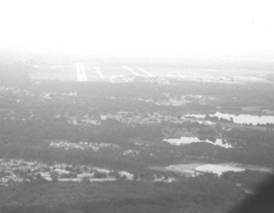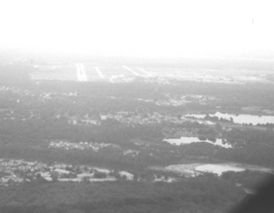
I grew up on the eastern seaboard, which has its own weather peculiarities. In the wintertime, it gets gray and overcast, it snows from late November to early March, and the contrails in the sky are all heading toward Florida.
In the summer it gets hot. It gets real hot. I remember a radio station in Baltimore, 104.3, offering $104,300 dollars to the lucky caller if the temperature reached 104 degrees one summer. It did. Several times. That promotion never happened again.
The weather from New England to Georgia gets dramatically affected by the Appalachian mountain chain. What happens is that an air mass will cross the mountains and then, like a tired old dog, just sit there, between the mountains and the Atlantic Ocean. In a matter of days, the onshore breezes push ocean air over land, increasing the humidity. Simultaneously, temperature levels start to rise and the visibility through the haze begins to deteriorate.
On the Chesapeake Bay, where Im from, it gets even worse because of natural water vapor there as well. This would not be so bad, except that the affected air mass has been known to stay there for weeks at a time. It wont move until a fairly strong front comes along that has the oomph to cross the mountains and push it out to sea. And the contrails in the sky still point to Florida.
The funny thing is that the FAA, with its sick sense of government humor, will continue to tell you that the weather is better than 5,000 and 5. Technically, this is true. There wont be any clouds below 5,000 feet and somewhere the measured visibility is at least five miles, but theyll never tell you where. Finding that location is like looking for the Holy Grail.
The Trap is Set
So you, the erstwhile pilot trying to maintain your skill and proficiency, head to the airport to fire up the airplane and take a friend for a $500 hamburger. Alls well until you roll down the runway, raise the nose and see … nothing. The blood drains out of your head and pools in your bladder, giving you the sudden and great urge to relieve yourself.
Unfortunately, the only relief youre likely to find is by looking straight down, because on days like this thats often the only sign of the ground youre going to get – unless your airplane is of the low wing variety, in which case you wont even get that.
But in all seriousness, you may have taken off with the intention of flying in VMC, only to find yourself in conditions that appear to your wandering eyes as milky white IMC with no visible horizon. Your slant-range visibility, as it is often called, is sort of like your 401(k) – pretty much zilch.
At low altitudes, the most important thing you can do is to immediately transition to instruments and fly the plane with your concentration locked on the panel. Fly a safe airspeed and pitch combination until you get to pattern altitude, and then try looking out the window again.
Be forewarned: The situation is probably going to be worse, but you should be able to see down fairly well. Picture yourself in the narrow end of a megaphone turned on its wide open end, that is moving across the ground, with the wide end being the limits of your vision. Navigating off a sectional alone is going to be difficult of not impossible. Avoiding restricted airspace and TFRs even more so.
Assuming that you keep your wits about you and eventually get back to an airport, its also going to affect your approach. The limited slant-range vis is going to create the illusion of the runway being farther away than it is. If its a fairly short strip, you may come in high and fast, so be prepared to do a go-around, realizing that it may be a mostly instrument maneuver.
Predicting the Mess
This problem is by no means limited to the East Coast. It happens just about everywhere, but gets worse when theres humidity around.
To avoid getting trapped, start with your weather briefings. If you know by looking outside that there is haze on the ground, be assured its going to be worse in the air. This is doubly true on a summer afternoon.
Find out where the visibility readings are being taken, get several of them, and then plot them on your charts. If the briefer notes a number of airports in your area or along your route of flight that are calling for haze and mist, thats a clue that VFR may not be a great option.
You may recall that when you were a student pilot getting ready to go on a solo cross country, your instructor was pretty adamant about having exceptionally good weather conditions. Lots of blue and not a lot of wind are pretty much the rule for student cross-countries. Once you have that ticket in hand, however, you alone are responsible for making the weather-related go/no-go decisions. One of the keys to making that job easier is learning how to interpret the information you receive during your briefing.
In recent years, there has been a proliferation of automated weather reporting stations installed at a number of small airports. These devices are designed to measure wind, altimeter settings, ceiling and visibility, and the data are broadcast on a designated frequency. On paper, these gadgets are great. They make weather available 24 hours a day without requiring a human to record the weather.
But they have their faults as well. The machines measure the winds and altimeter pretty accurately, but the ceiling and vis values are skewed by the way the machines measure the environment – often calling the weather better than it is.
The fallacy that may befall you is that most of these ASOS machines also have a telephone number that you can call to hear the same recording you would get over the radio while en route. While there is no reason you should not call them, you should not rely on just one or just on the automated systems in general for your weather info.
Call several of them along or near your route of flight. If you are going to be flying near some busy Class B or C airspace, track down a phone number to call the ATIS at the major airport served. While many of these are computerized now as well, some are not. If the controllers feel emphasis is needed on a specific weather issue, it will be included in the ATIS.
If multiple airports are reporting haze, or varying degrees of vis within a relatively small geographic area, be prepared for low slant-range visibility. If you arent ready for it, it can flat out scare you. The view out the window will look like you are in a cloud even though you arent.
If you are going to be flying over any water or barren terrain, you will be wise to assume that you will effectively be in IMC during that portion of the flight. There will be a decided lack of a discernable horizon.
When Trouble Arises
The hazards associated with flight in which VFR is legal but not necessarily practical creates the perfect scenario for a VFR-into-IMC type of disorientation accident. Thats just another reason you should stay up on basic instrument flight skills, even if you are not IFR rated. It sounds like a contradiction, but it really isnt, and on days of heavy haze, good instrument skills will actually make such a flight easier. It should go without saying that solid instrument navigation skills will be necessary as well.
Haze-induced loss of visibility usually has an effective solution – at least when going cross-country: climb. The top of the haze layer is often well below 10,000 feet – usually around 5,000 to 6,000 feet. While getting your weather briefing, try to find out where the top of the layer is.
On top of the layer should be considered the prime place to fly. The ride will almost always be smoother and the air will be much clearer, which will add greatly to the comfort level. Youll also save some gas with proper leaning.
While the hazards of poor visibility can pop up just about any time, the danger is the greatest at night. The potential for a disorientation event soars, especially because the lights on the ground may be fuzzy and blurred in the haze and the stars above may barely be visible. The flashing of your strobes can bother your vision and can itself be disorienting.
Assume that the combination of haze and night equals IMC from a practical standpoint, even if the weather is legally above VFR minimums. In addition to the navigation issues and the fact that the horizon is less visible at night in all but the most favorable conditions, night haze adds the danger that you may not see a cloud before you find yourself in one. Unless you are instrument-rated, current and proficient, give it serious second thoughts.
Poor slant-range visibility can be misleading and uncomfortable for a number of reasons. Use your best judgment, and realize that slant-range vis, forward vis, and straight down vis are not the same things. The lack of slant-range vis can quickly lead to disorientation and getting lost, which can lead to fear, panic, and a definite lack of enjoyment in flying.
-by Chip Wright
Chip Wright is an airline captain and CFII.




